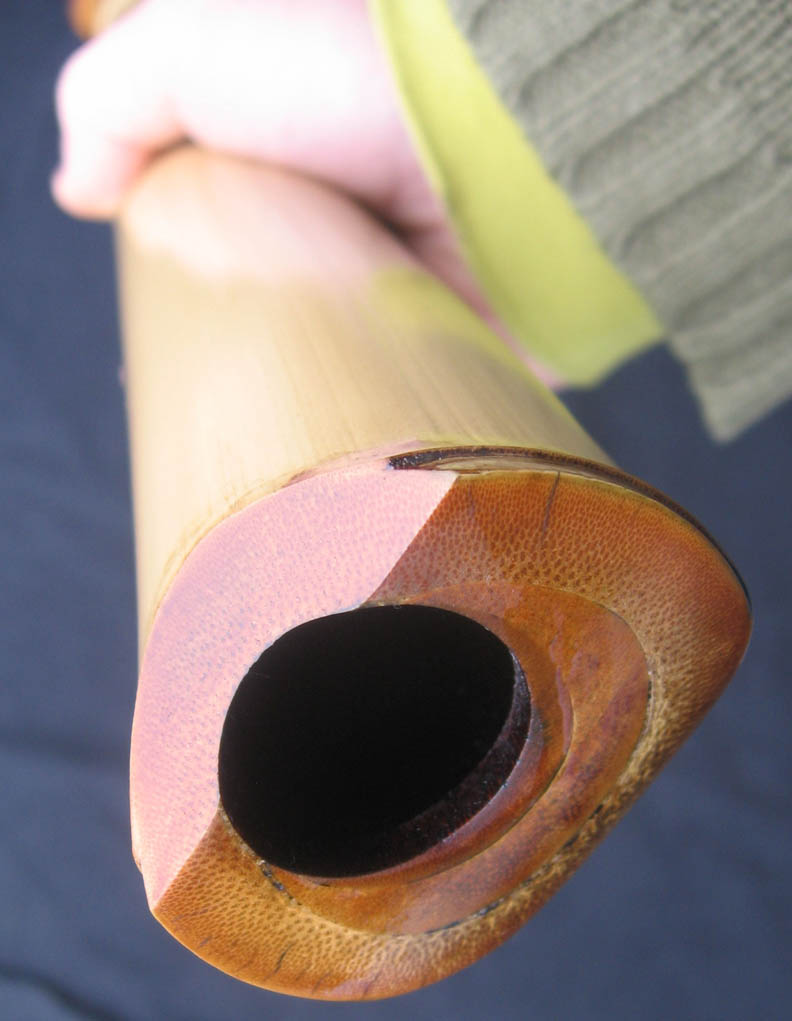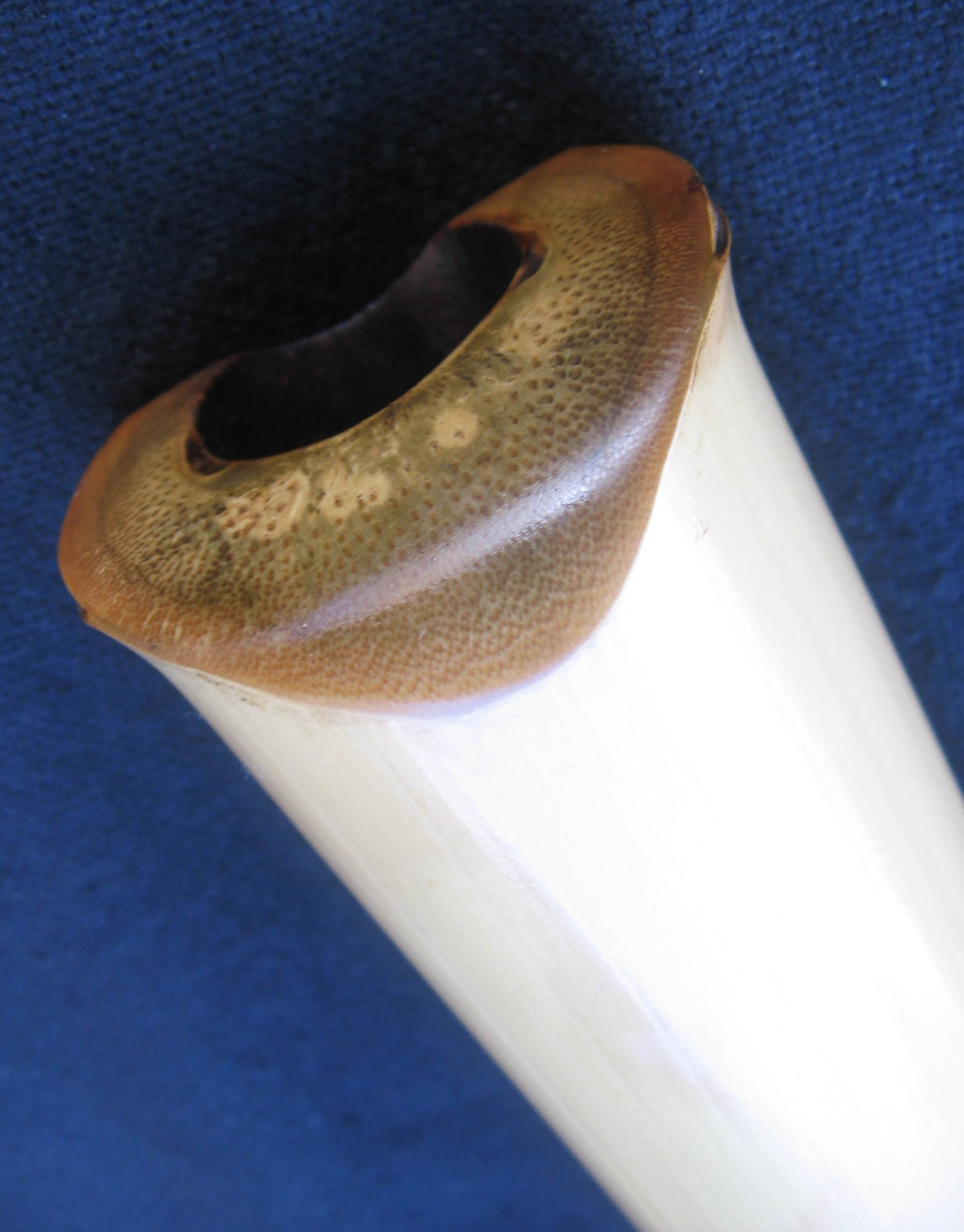Mujitsu and Tairaku's Shakuhachi BBQ
World Shakuhachi Discussion / Go to Live Shakuhachi Chat
You are not logged in.
Tube of delight!
#1 2007-03-19 16:12:35
- Kabato
- Member

- From: New York City
- Registered: 2007-02-26
- Posts: 28
About ikigaeshi
I've got some really nice bamboo coming to me soon and I wanted to clear up a question I had about ikigaeshi. Since I've never actually worked on a flute with a bore wide enough to need one, I never really worked out how one goes about adding one. I assume to "leave the natural ikigaeshi" means to leave a part of the actual node and let that be the ikigaeshi. If one decides to add one, where does the piece of additional bamboo come from? Another node somewhere else on the same pole?
Just to clarify I have an example of two Mujitsu Shakuhachi, one with each type of ikigaeshi:
Added
Natural
If you say that you do not need to fan yourself because the nature of wind is permanent and you can have wind without fanning, you will understand neither permanence nor the nature of wind. The nature of wind is permanent; because of that, the wind of the buddha's house brings for the gold of the earth and makes fragrant the cream of the long river.
-Eihei Dogen, Genjokoan
Offline
#2 2007-03-19 16:45:02
- philthefluter
- Member

- From: Dublin, Ireland
- Registered: 2006-06-02
- Posts: 190
- Website
Re: About ikigaeshi
The ikigaeshi can be added using a mixture of resin and bamboo powder. I have not tried it myself so am unsure of the exact technique used.
"The bamboo and Zen are One!" Kurosawa Kinko
http://www.shakuhachizen.com/
http://www.myspace.com/shakuhachizen
Offline
#3 2007-03-19 17:03:38
Re: About ikigaeshi
The bamboo & CA glue method... Start with very fine bamboo dust (you always save it from filing & sanding, don't you?), place and shape some on the surface to be built up, put a drop or three of thin CA glue onto the "pile" of dust. You might remove the remaining thin membrane first, or you might use that as a foundation to build on top of. Once applied, the CA will wick quickly throughout the dust and begin its magical reaction.
The new material will let off a very small amount of visible and invisible gas (don't breath the fumes) as the CA reacts with the moisture in the dust & air. Let dry for a few mins. Sand/file, shape, and repeat with another layer and another layer, etc. You can build a thin or thick "wall" of material this way, and it's extremely strong and very easy to work later with tools, including drills.
It can be polished to a very smooth, comfortable surface for the lips/chin. CA, once dry, is inert and won't react with skin at all. The color of the end result will be complementary to the natural bamboo.
This method can work for even a fairly large opening. But cutting a crescent or slice of bamboo to cover the bulk of it is another option (as those pics show).
Try the CA+dust method once on some scrap and you'll understand how easy and useful it can be.
-Darren.
When it is rainy, I am in the rain. When it is windy, I am in the wind. - Mitsuo Aida
Offline
#4 2007-03-19 19:18:52
Re: About ikigaeshi
Kabato wrote:
I've got some really nice bamboo coming to me soon and I wanted to clear up a question I had about ikigaeshi. Since I've never actually worked on a flute with a bore wide enough to need one, I never really worked out how one goes about adding one. I assume to "leave the natural ikigaeshi" means to leave a part of the actual node and let that be the ikigaeshi. If one decides to add one, where does the piece of additional bamboo come from? Another node somewhere else on the same pole?
Kabato,
This is how I insert a bamboo ring:
First, find a very thick, but smaller diameter bamboo culm. Then, set the end on top of the flute and line it up so you can trace around the end of the culm onto the top end of the blowing end. Grind out the top blowing end until the opening lines up with the line that was traced. Slightly bevel all around the end of the smaller culm. Do this until the the beveled end fits snugly into the top blowing end (about 5mm deep or less). You can tilt it at a slight angle towards the back of the flute if you wish. Glue it in. Cut off the top and finish. Grind open the the blowing end to the desired width.
This will also work with a hardwood dowel instead of bamboo.
Both this and the glue/sawdust method have their own aesthetic appeal.
I hope this helps.
Ken
Offline
#5 2007-03-19 22:16:25
- Kabato
- Member

- From: New York City
- Registered: 2007-02-26
- Posts: 28
Re: About ikigaeshi
I figured it was probably something like that, thanks for clarifying that. In the flute with the natural ikigaeshi is any CA glue + bamboo dust used?
If you say that you do not need to fan yourself because the nature of wind is permanent and you can have wind without fanning, you will understand neither permanence nor the nature of wind. The nature of wind is permanent; because of that, the wind of the buddha's house brings for the gold of the earth and makes fragrant the cream of the long river.
-Eihei Dogen, Genjokoan
Offline
#6 2007-03-19 23:03:52
Re: About ikigaeshi
Kabato wrote:
I figured it was probably something like that, thanks for clarifying that. In the flute with the natural ikigaeshi is any CA glue + bamboo dust used?
On that particular flute, there is only the natural node. On the left and right, you can see dark areas. These are natural indentations of the node which have been darkened with an urushi stain that was applied to the whole area.
The bamboo node can sometimes be accomidating by providing a nice slope to the area. Often, on wide bore shakuhachi it is not. So, something needs to be done to fill in the area to make playing more functional.
Happy noding.
Ken
Offline
#7 2007-03-20 03:48:23
- radi0gnome
- Member

- From: Kingston NY
- Registered: 2006-12-29
- Posts: 1030
- Website
Re: About ikigaeshi
I take it that ikigaeshi is what some people call a breath return. I've been wondering since I first saw them, what are they for? Are they required on large bore instruments?
"Now birds record new harmonie, And trees do whistle melodies;
Now everything that nature breeds, Doth clad itself in pleasant weeds."
~ Thomas Watson - England's Helicon ca 1580
Offline
#8 2007-03-20 10:31:39
- Kabato
- Member

- From: New York City
- Registered: 2007-02-26
- Posts: 28
Re: About ikigaeshi
An ikigaeshi shrinks the top opening on a really wide flute, which allows your lower lip to comfortably rest in a place that puts the blowing edge where it should be.
If you say that you do not need to fan yourself because the nature of wind is permanent and you can have wind without fanning, you will understand neither permanence nor the nature of wind. The nature of wind is permanent; because of that, the wind of the buddha's house brings for the gold of the earth and makes fragrant the cream of the long river.
-Eihei Dogen, Genjokoan
Offline
#9 2007-03-21 00:53:30
- Yungflutes
- Flutemaker/Performer

- From: New York City
- Registered: 2005-10-08
- Posts: 1061
- Website
Re: About ikigaeshi
Kabato wrote:
An ikigaeshi shrinks the top opening on a really wide flute, which allows your lower lip to comfortably rest in a place that puts the blowing edge where it should be.
Hi Kabato, That is definately one reason for the ikigaeshi. It also has a more functional, technical reason - it seals the back on large bore flutes from air leaks. An ikigaeshi affects the sound and response so it has to be adjusted for the best functionality. This is usually dictated by the maker's level of technical playing and style of music the flute is made for.
I just did a natural ikigaeshi today you can visit my blog for photos
http://www.yungflutes.com/log
I'll be doing a custom ikigaeshi inlay tomorrow on an old flute from Kyoto.
Ichion jobutsu, Perry
"A hot dog is not an animal." - Jet Yung
My Blog/Website on the art of shakuhachi...and parenting.
How to make an Urban Shakuhachi (PVC)
Offline
#10 2007-03-21 16:59:38
- Kabato
- Member

- From: New York City
- Registered: 2007-02-26
- Posts: 28
Re: About ikigaeshi
Thanks Perry, great to see it step by step.
If you say that you do not need to fan yourself because the nature of wind is permanent and you can have wind without fanning, you will understand neither permanence nor the nature of wind. The nature of wind is permanent; because of that, the wind of the buddha's house brings for the gold of the earth and makes fragrant the cream of the long river.
-Eihei Dogen, Genjokoan
Offline
#11 2007-03-21 20:39:38
- radi0gnome
- Member

- From: Kingston NY
- Registered: 2006-12-29
- Posts: 1030
- Website
Re: About ikigaeshi
Armed with the recent information in this thread I decided to try converting a bamboo didjeridu into a shakuhachi today. So, after pulling off the wax, I sawed of the top to get to the node, and then sawed by eyeballing what looked like a 30 degree angle for the utaguchi. I was kind of surprised when I tried it I was immediately able to get a sound, but the gash I made in it seemed too severe so I tried building it back up with the CA glue and bamboo dust. I found out quickly that the slower curing gel kind of superglue glue doesn't work very well for mixing with bamboo dust. What was mentioned about the capillary action doesn't happen. But, regular superglue worked fine and I was able to build up enough surface for me to file off. That stuff is tough. I spent about a half hour with a file that works OK on PVC but I still have a lot more to file down. I obviously need to get a heftier file. So I went from some really crude and fast hacking to being able to get a sound to spending a lot more time (still pretty crude though) to having no sound. I'll let you know how it works out, it's about 3 1/2 feet so I don't think I'll try putting in finger holes, but I'll think about that more after I get the mouthpiece working again.
"Now birds record new harmonie, And trees do whistle melodies;
Now everything that nature breeds, Doth clad itself in pleasant weeds."
~ Thomas Watson - England's Helicon ca 1580
Offline
